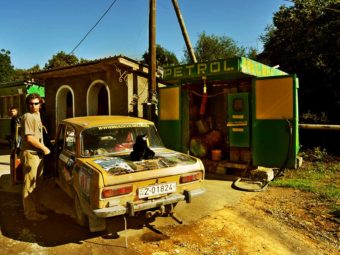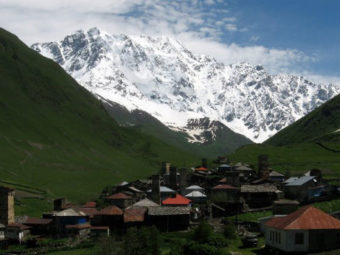FOR THE ENGLISH VERISON – SCOLL DOWN!
A batumi pihenő-munkanap után nekivágtunk a festői Adjarianak. Ez az országrész arról nevezetes, hogy egyetlen műút szeli keresztül, amelyet minden térkép vastag piros vonallal jelöl. A valóságban az M8-as pont olyan, mint a magyar: nem létezik. A piros vonal is inkább azt jelentheti: ne használd! Nekünk azért pont megteszi majd, mert a táj elképesztő. Gyönyörű szurdokokban, lélegzetelállító fennsíkokon, és szinte járhatatlan hegyi ösvényeken halad majd a verseny útvonala e szakaszon.
Az útvonalvezetésen két okból sem szabad kiakadnia a Kaukázus Rali résztvevőinek. Egyrészt el kell fogadni, hogy errefelé ennyire telik, másrészt pedig belegondolni, hogy a helyieknek naponta kell ezeken az utakon járniuk. Mondjuk a népsűrűség is pont ennek megfelelő. Néha szembejött egy-egy Niva, Zil, Kraz, esetenként pedig a régi Ford Transitokból, és vakmerő sofőrjeikből álló marshutka-hálózat némely tagja, és ennyi. No meg néhány, ki tudja honnan, ki tudja hová gyalogló ember. Ez egyébként felderítő utunk egyik visszatérő kérdése volt (ahogy korábbi, afrikai útjainké is): mit keresnek ott, ahol néha valóban a madár is csak átrepülőben jár?
Eddigi sima utunk után ideje volt már egy kis nehézségnek, és ezt meg is kaptuk. A következő napokban semmi sem alakult úgy, ahogyan szerettük volna. (Attila tervez, Isten végez.) A Kaukázus Rali két legnehezebb hágóját elzárta előlünk a hó, így Adjariában és a Svaneti régióban (ez a legvadabb Magas Kaukázus) is többszáz kilométeres kerülőket kellett tennünk, hogy bejárhassuk a teljes útvonalat, és kitűzhessük a feladatokat.
Itt az út vége, 2400 méteren, május végén. Csak hegyi kecskék járnak erre, mint a mellékelt (bogyós) ábra mutatja. Idén még Krazzal sem keltek át.
Ezeken a területeken még a járható útszakaszokon is csak 10-15 km/óra az átlagsebesség, így egy-egy útakadály egyik pillanatról a másikra írta át útitervünket (bár alant pont egy tökéletesen járható hid látható).
Amikor nem a hóakadályok, akkor a technika hátráltatott minket. Egy útszéli defektet lehet persze tragédiaként, és lehetőségként is értékelni. A mi hozzáállásunk is megváltozott, amint megállt mellettünk egy hegyvidéki lakosokat szállító kisbusz, és az utasok szinte kivették a kezünkből a szerszámainkat. Jó volt megtapasztalni, hogy errefelé még valóban segítenek a bajba kerülteknek, és azt is, hogy a vendéglátást az út mentén sem felejtik el.
Gyorsan átalakultak a szerepek is kis csapatunkban: míg Szabi a szakszerűségért aggódott (feleslegesen), Attila a népek barátságát ápolgatta a segítőinktől ajándékba kapott védőitalokkal, valamint előásta a Jennyben napok óta lapuló istentudjamibőlkészült/útszélénvásárolt házipálinkát cserébe. Mindezt természetesen kizárólag önfeláldozásból, hiszen mindenütt irva vagyon és komolyan kell venni: egy grúzt soha nem sérthetsz meg jobban, mint ha visszautasitod a felkinált italát. De tényleg.
Ha pedig nem az időjárás és nem is a technika szólt közbe, akkor a térség politikai helyzete késztetett bennünket útvonalmódosításra. Dél-Oszétiába minden igyekezetünk ellenére sem sikerült bejutnunk, mert legvégül – kedvesen ugyan, de – megálljt parancsolt nekünk Oni város rendőrfőnöke. Persze nem hittük el, hogy az oszétok emberevő szörnyetegek lennének (ahogy ezt arrafelé beállították), de nem volt választásunk – rendőri kíséretet kaptunk egészen addig, amíg egyértelművé nem vált, hogy nem fordulunk ismét a határ felé vezető útra.
Noha Szabi már meg volt győződve arról, hogy Kutaisi városa a mi Bermuda háromszögünk, ahonnan sosem szabadulunk, minden akadályozó tényező ellenére is hiánytalanul kitűztük az ötnapos grúz szakasz útvonalát és feladatait. Eljutottunk az elképesztő Ushguliba (Európa legmagasabban fekvő, állandóan lakott településére), bebarangoltuk a csodálatos Racha régiót, és Tbilisziben is nagyon vicces gyalogos etapot sikerült kijelölnünk a versenyzőknek.
Talán mondanunk sem kell, hogy az otthoni médiában szajkózott “bizonytalan grúz helyzet” is csak annyira volt bizonytalan, mint egy háromlábú szék. Huba még tüntetett is egy kicsit viccből, és csak kevés (vodka) tartott vissza, hogy ne vonuljunk mindannyian utcára egy “Monnyonle!” feliratú transzparenssel. Végül is lepedő lett volna a szállodában, festékszórónk is volt Jenny hátsójában…
Szóval minden eddiginél nehezebb, a CC korábbi résztvevői számára is ismeretlen, csodálatos tájak várják szeptemberben a második Kaukázus Rali indulóit Grúziában.
=============================================================
After a day off in Batumi we started off for the picturesque Adjaria. This part of the country has one major road crossing it which is marked with thick red line on every map. In reality it doesn’t exist. I mean it does exist in some form but the red line might mean ‘do not use it!’ Well, it’s just the road for a challenge in the Caucasus, so no complaints… and the landscape is astonishing! Wonderful canyons, beautiful highlands and almost impassable mountain passes are the highlights of this stage of the rally.
We have no other option than accept the fact that this is the only road here and the locals use this as well. Actually the density of the population is in correlation with the quality of the roads. Once in a while there was a Niva, a Zil or a Kraz coming our way and occassionally a member of the marshrutka network of old Ford Transits and their brave drivers. That’s it.
And some folks walking from and to who-knows-where. One of the recurring questions was where the heck are these guys walking to (and from) in the middle of the nowhere? Just like Africa, we had the same experience there.
We had a pretty ‘smooth’ day so far, so it was hight time we got some troubles. Nothing went as planned in the upcoming days. Two of the most difficult mountain passes were closed due to the snow, one in Adjaria and the other one in Svaneti region, so we had to make a couple of hundred kilometers of detour to cover the planned route and fix the challenges. On these roads the average speed is 10-15 kilometers an hour.
This is the end of the road on 2400 meters end of May. Only goats use this road as you can see on the photo below. Even the Kraz cannot pass this.
When there was no snow blocking our way we had to cope with technical difficulties. We were lucky enough to get a flat tire when it was not raining and immediately we got help from the driver and passenger of a local marshrutka – whether we asked for it or not 🙂 They actually took the tools out of our hands and started to change the tire themselves.
And they didn’t miss reminding us for Georgian hospitality so within a minute one of them appeared from the back of the van with a huge bottle of beer and started to make cups from plastic bottles in order to drink beer properly.
So while Szabolcs was (unnecessarily) worried about the remove-install process of the tires Attila was making friends with the booze we got from our helpers. He dig in Jenny’s back to return the favour and handed over a half bottle of home made cornel spirit we bought a couple days ago (let’s call it a difficult-to-drink material). While we (they) changed the tires we all consumed each other’s drinks. We read it several times and took it seriously: never offend a Georgian with not accepting his drink.
And when we had no problems with the geographic and technical situation politics was the problem making us change our route plans. We couldn’t get into South Ossetia even though we tried it hard. The kind but determined chief police officer stopepd us n our way from Oni to the Ossetian border ans asked us to go back to Oni and take the other road. We tried to convince them that we do not believe that Ossetians are cannibal monsters but it didn’t help. We got police escort until they were sure we took a ‘safe’ road down South.
Although Szabolcs was sure that Kutaisi is our Bermuda triangle as whichever road we took after a while we always ended up there, in contempt of all the difficulties we successfully made all the challenges and had the final route ready in Georgia. We made it up to the fascinating village of Ushguli (said to be the highest permanently inhabited village in Europe), roamed around the wonderful region of Racha and again we set up a funny walking ‘tour’ as the last stage for the day (for the competitors) in Tbilisi.
Huba even went for a small (political) rally in Tbilisi with a young group of demonstrators just for fun and only good old laziness kept us from marching out on the streets together with a banner with ‘Resign!’ (or something similar) on it. We had clean sheets in the hotel and paint sprays in the car… but later on we decided to drink another beer 🙂
So the participants of the second Caucasian Challenge will face more difficult but at the same time more beautiful stages in Georgia than ever.






Leave a Reply